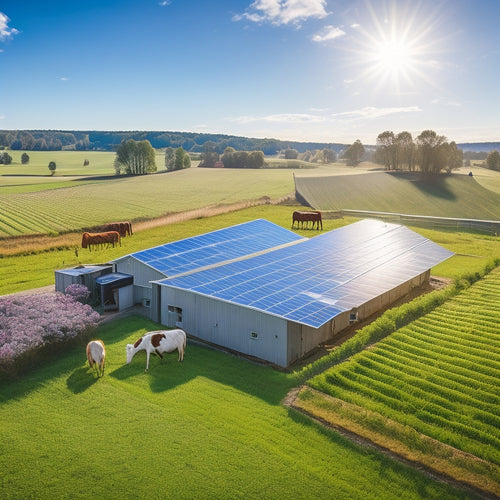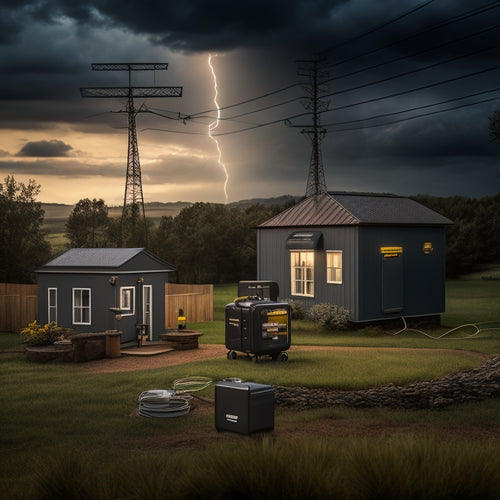
Off Grid Solar for Home
Share
You're considering off-grid solar for your home, a decision that can eliminate your reliance on the grid and result in zero utility costs over time. With an initial installation cost of $15,000 to $30,000, you can expect significant long-term savings and a return on investment through reduced energy bills. Off-grid solar systems can increase your property value by up to 15-17%, and with tax incentives covering 30% of installation costs, it's becoming a more financially viable option. As you investigate this sustainable energy solution, you'll want to assess your energy demands, optimize your system's performance, and access the full benefits of going off-grid - and that's just the beginning.
The Essentials
- Off-grid solar systems provide energy independence, eliminating reliance on the grid and resulting in zero utility costs over time.
- Initial installation costs range from $15,000 to $30,000, but pay off through reduced energy bills and long-term savings.
- Off-grid solar systems can increase property value by up to 15% to 17%, appealing to environmentally conscious buyers.
- Assessing daily energy demands is crucial for accurate system sizing, considering peak usage times and low energy demand periods.
- Maximum Power Point Tracking (MPPT) technology optimizes energy harvesting efficiency, yielding up to 30% more energy harvested from the sun.
Zero Energy Bills
You'll save money now by reducing your energy expenses, and with an off-grid solar system, you'll enjoy zero utility costs in the long run.
By utilizing renewable energy from the sun, you'll minimize your reliance on the grid, resulting in significant cost savings.
With zero energy bills, you can allocate your financial resources to other important aspects of your life.
Save Money Now
Nearly 90% of homeowners are interested in reducing their energy bills, and going off-grid solar is an effective way to achieve this goal. You'll save money now by utilizing free energy from the sun, reducing your reliance on the grid, and taking advantage of tax incentives.
By investing in off-grid solar, you'll avoid rising electricity costs and lock in a fixed energy rate. The initial installation costs may seem high, but they'll pay for themselves over time through reduced energy bills.
Here's a breakdown of the costs and benefits:
| Cost/Benefit | Off-Grid Solar | Traditional Grid |
|---|---|---|
| Installation Costs | $15,000 - $30,000 | $0 (already connected) |
| Monthly Energy Bills | $0 (free energy) | $100 - $300 |
| Tax Incentives | 30% of installation costs | $0 |
With off-grid solar, you'll enjoy significant savings and freedom from the grid. You'll no longer be subject to rate hikes or blackouts, and you'll be doing your part for the environment.
Zero Utility Costs
With your off-grid solar system up and running, you can say goodbye to those pesky monthly energy bills. You'll no longer be tied to the grid, and you'll enjoy the freedom that comes with zero utility costs.
This means you can allocate your hard-earned money towards more important things, like your family, hobbies, or investments. By opting for an off-grid solar power system, you'll be able to utilize the power of the sun for your home or business, breaking free from the constraints of traditional grid-based energy.
To achieve this level of energy independence, you'll need to ascertain your system is designed to meet your energy needs. This may involve investing in battery storage solutions to store excess energy generated during the day for use during the night or on cloudy days.
With the right system, you can enjoy a steady supply of clean energy, without relying on the grid. Fortunately, there are solar financing options available to help make your off-grid dream a reality. From loans to leases, you can find a financing option that fits your budget and financial goals.
Increased Property Value
You're likely to see a significant increase in your property's value once you've installed an off-grid solar system, which can provide an affordable way to reduce your electricity bills through individual solar panel units solar panel cost.
This renewable energy upgrade can lead to higher resale prices, making your home more attractive to potential buyers.
In fact, studies have shown that homes with solar panels can sell for up to 15% more than similar homes without them.
Renewable Energy Upgrade
By investing in a renewable energy upgrade, homeowners can considerably increase their property value, making their off-grid solar home a more attractive option for potential buyers if they ever decide to sell.
This upgrade can include a solar panel installation, energy storage solutions, and other sustainable features that appeal to environmentally conscious buyers. As you shift to an off-grid system, you'll reduce your environmental impact and enjoy energy independence.
Furthermore, rooftop solar panels increase home value and provide a sense of peace and responsibility that comes with embracing sustainable energy solutions. Additionally, you may be eligible for solar incentives, which can further increase your property value.
To maintain your system's efficiency, follow maintenance tips and consider DIY solar projects to optimize performance. With renewable technology advancements, your off-grid solar home will become an attractive investment opportunity for like-minded individuals seeking a sustainable lifestyle.
Higher Resale Prices
Investing in a renewable energy upgrade can have a significant impact on your property's resale value. As you consider going off-grid with solar, it's crucial to think about the long-term benefits, including increased property value.
According to recent solar market trends, properties with solar installations sell for higher prices than those without. In fact, studies have shown that solar-equipped homes can sell for up to 17% more than similar homes without solar.
This increased resale value is largely driven by property buyer preferences. Today's homebuyers are increasingly environmentally conscious and energy-efficient. They're willing to pay a premium for homes that offer sustainable living and reduced energy costs.
As a homeowner, investing in an off-grid solar system can be a savvy move, not only for the environmental benefits but also for the potential return on investment when you decide to sell.
Maximum Power Point Tracking
You'll want to guarantee your off-grid solar system is equipped with a maximum power point tracking (MPPT) controller, as it's essential for efficient energy harvesting.
When selecting a deep cycle battery for your off-grid solar system, consider a reliable energy storage solution that can provide a power backup system home battery systems during periods of low sunlight.
MPPT technology allows your system to optimize power output by continuously monitoring and adjusting to the solar panels' maximum power point, despite changes in temperature and irradiance.
Efficient Energy Harvesting
Efficient energy harvesting is critical to maximizing the power output of your off-grid solar system. You've invested in solar panel technology to achieve grid independence and reduce your environmental impact.
To get the most out of your system, you need to guarantee efficient energy harvesting. This is where maximum power point tracking (MPPT) comes in. MPPT is a technique that tracks the maximum power point of your solar panels, allowing your system to extract the maximum amount of energy.
With MPPT, you can optimize your energy storage solutions, guaranteeing that your batteries are charged efficiently. This not only extends your battery lifespan but also reduces system maintenance.
By maximizing your energy harvesting, you can enjoy the benefits of sustainable living, including reduced energy bills and a lower carbon footprint. Plus, with solar incentives, you can offset the cost of your DIY installation.
Optimized Power Output
As your off-grid solar system generates power, its output varies depending on factors like temperature, irradiance, and panel mismatch.
To guarantee you're getting the most out of your system, you need to enhance its power output. This is where Maximum Power Point Tracking (MPPT) comes in.
MPPT is a technique used to maximize the energy output of your solar panels by tracking the ideal operating voltage and current.
Assess Your Energy Demands
You need to determine your daily energy usage patterns to accurately size your off-grid solar system. This involves tracking your energy consumption throughout the day, including peak usage times and periods of low energy demand.
Consider investing in a renewable energy solution that can help you reduce your reliance on the grid and lower your electricity bills.
You'll also need to calculate the power requirements of each appliance, considering factors like wattage, voltage, and usage duration.
Daily Energy Usage Patterns
Determining your daily energy usage patterns is essential in sizing an off-grid solar system that meets your needs. You need to understand how much energy you consume daily to determine the required solar panel placement, battery storage options, and energy efficiency tips.
| Time of Day | Energy Consumption | Lifestyle Energy Habits |
|---|---|---|
| Morning | High (lights, fridge, coffee maker) | Wake-up routine, breakfast prep |
| Afternoon | Low (only fridge and occasional uses) | Leisure time, outdoor activities |
| Evening | High (lights, TV, cooking) | Dinner prep, relaxation |
Analyzing your energy consumption trends reveals seasonal usage variations. For instance, you may use more energy during winter for heating or summer for cooling. Your lifestyle energy habits, such as cooking frequency or entertainment choices, also impact your energy demands. By understanding these patterns, you can optimize your off-grid solar system, incorporating alternative energy sources and selecting suitable off-grid appliances. This guarantees a reliable and efficient energy supply, giving you the freedom to live off the grid.
Appliances' Power Requirements
To accurately size your off-grid solar system, calculate the total power requirements of your appliances, evaluating their individual wattage ratings and usage patterns. This will help you determine the required solar panel capacity and energy storage solutions for your system.
Make a list of all your appliances, including lights, refrigerators, computers, and TVs. Check the wattage rating of each appliance, usually found on the device or in the user manual. Calculate the total wattage by multiplying the wattage rating by the number of hours you use each appliance daily. For example, if you use a 100W laptop for 8 hours, its daily energy requirement is 800Wh.
Next, add up the total daily energy requirements of all your appliances to determine your total power demand. This will give you an idea of the minimum solar panel capacity and energy storage solutions you need to meet your energy demands.
Be sure to evaluate peak usage times and adjust your calculations accordingly. By accurately analyzing your energy demands, you can design an off-grid solar system that provides reliable power and freedom from the grid.
Higher Efficiency Conversion Rate
You'll want to enhance your off-grid solar system's conversion rate by incorporating max power point tracking (MPPT) technology.
MPPT guarantees your system operates at its maximum potential by continuously monitoring and adjusting to the ideal voltage and current output.
Max Power Point Tracking
Within off-grid solar systems, maximizing energy harvest is vital, and that's where Max Power Point Tracking (MPPT) comes into play, ensuring your system operates at its highest capacity by continuously monitoring and adjusting to the ideal power point of your solar panels.
MPPT is an essential component in solar technology, allowing you to enhance energy production and storage.
It flexibly adjusts the voltage and current output of your solar panels to match the best operating point, resulting in up to 30% more energy harvested.
This technology is particularly important in off-grid systems, where energy storage is limited and every watt counts.
Frequently Asked Questions
Can I Install Off-Grid Solar Panels on My Own?
You can attempt a DIY installation, but it's essential you prioritize safety considerations, ensuring you're comfortable with electrical work, have the necessary knowledge, and follow local building codes to avoid potential risks and hazards.
How Do I Deal With Limited Roof Space for Solar Panels?
When dealing with limited roof space, you'll need to investigate solar panel alternatives, like vertical or adjustable panels, and focus on maximizing efficiency by optimizing panel placement, angle, and cleaning schedules to guarantee maximum energy output.
Are Off-Grid Solar Systems Compatible With Existing Electrical Systems?
You're likely aware that 70% of US homes can't install rooftop solar due to shading or structural issues. Fortunately, you'll find that off-grid systems are designed to seamlessly integrate with existing electrical systems, ensuring system compatibility and efficient electrical integration for a hassle-free shift to energy independence.
Can I Use Off-Grid Solar Power for My Entire Home?
You can achieve energy independence by relying solely on off-grid solar power for your entire home, but be prepared to prioritize system maintenance to guarantee consistent performance and maximize your freedom from the grid.
Do I Need a Backup Generator With an Off-Grid Solar System?
Imagine waking up to a dark, silent morning, but with a twist - you're still powered up! You're considering skipping the backup generator, but without it, you'll risk losing your energy independence when the sun dips and battery storage is depleted.
Final Thoughts
Going off-grid with solar power means you'll enjoy zero energy bills, increased property value, and maximum power point tracking for ideal energy harvesting. By evaluating your energy demands, you can guarantee a seamless shift. With higher efficiency conversion rates, you'll maximize your solar panel investment. Did you know that a typical American home with a solar power system can save up to $500 per year on energy costs? That's a significant return on investment, making off-grid solar a smart choice for your home.
Related Posts
-

What Do I Need to Know About Farm Solar Panels
When considering farm solar panels, you need to assess costs, benefits, and technical specifics. Initial investment c...
-

Why Outdoor Solar Lighting Systems Are Sustainable
Outdoor solar lighting systems are sustainable because they utilize renewable energy, drastically reducing your carbo...
-

Key Components of a Reliable Emergency Power Supply System
A reliable emergency power supply system requires several key components. You need proven performance metrics to guar...


